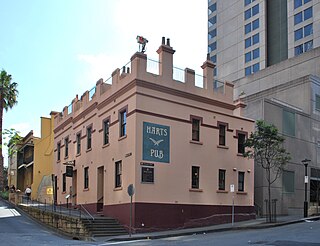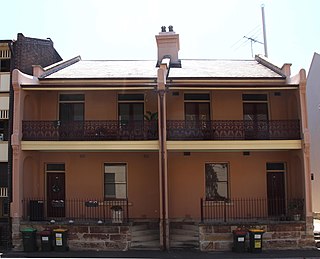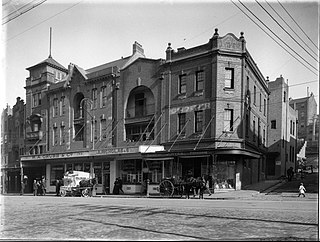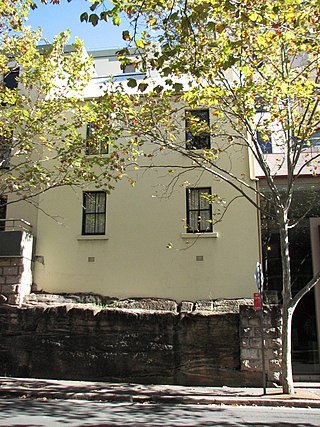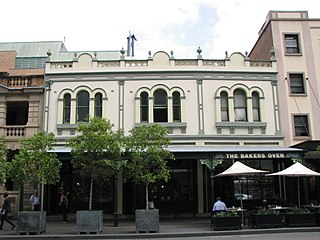Heritage listing
As at 19 November 2008, 147 George Street was constructed in 1911, a part of a group of four buildings, and has State Heritage significance for its historic and social values. [1]
147 George Street has historic significance at State level for having been the site of early European settlement, continuously occupied by Europeans since 1788. The site has historic significance at local level for its associations with several phases of 20th century urban renewal. Firstly, the demolition and rebuilding of much of The Rocks under the Observatory Hill Resumption Act following the 1900 plague outbreak; secondly, an association with infrastructure works including the construction of the Cahill Expressway and the City Railway link, which dramatically changed the visual curtilage of the group; and lastly, the 1980s creation of The Rocks as a tourist destination, when the interior and rear of the building was altered to accommodate a Duty Free Store (DFS) Complex. [1]
147 George Street forms part of a group of four commercial buildings (Nos 145, 147, 149-151 & 153-155 George Street) which front George Street and form the eastern portion of the DFS Complex. This group of buildings, bounded by Globe Street and the Cahill Expressway, mark George St's southern entry to The Rocks precinct. The facades of the four late 19th century and early 20th century buildings, have streetscape qualities and character that contribute to the overall richness of a coherent and harmonious brick and stucco group of buildings located within The Rocks. The subject building also has local significance in its use of the arch as the dominant feature of the east elevation. [1]
The significance of the subject site and the group is associated with its location in The Rocks, a precinct unique to NSW and its historic associations and streetscape character and qualities that contribute to The Rocks area, which has State heritage significance in its own right. The group is an important part of The Rocks Heritage Conservation Area being sympathetic in scale and character and an extension of the remaining earlier buildings of George Street, presenting a unified streetscape. The buildings are tangible evidence of the redevelopment of The Rocks in the last decade of the 19th century and the first decade of the 20th century, the period before and after the plague outbreak. 147 George Street has high social significance as a contributory element associated with the historic character of The Rocks, which is held in esteem by the local community and to the people of NSW. [1]
147 George Street was listed on the New South Wales State Heritage Register on 10 May 2002 having satisfied the following criteria. [1]
The place is important in demonstrating the course, or pattern, of cultural or natural history in New South Wales.
147 George Street, The Rocks has associations as a built element within George Street. George Street was the first road created in NSW and is thus the oldest road in Australia. The history of George Street (north) and its uses & changes since 1788, illustrate and inform the aspirations and way of life of Europeans in Australia. The Rocks was impacted by the plague of 1900. The Observatory Hill Resumption Act resulted in the resumption of large tracts of land. Post-plague re-development of The Rocks saw the demolition of a large number of buildings and the construction of new buildings that met health standards and requirements. 147 George Street was impacted by the urban development as were the other buildings in the group of four (except 145 George Street). 147 George Street has moderate significance at local level associated with the provision and retail of fish to the local area, continuously operating on the site for almost 70 years. As a part of the district of The Rocks it has association with maritime use and the sale and consumption of fish. 147 George Street has moderate significance at local level for its associations with the phase of redevelopment of The Rocks in the 1980s when the precinct was transformed into a major tourist attraction. As part of the development works in the 1980s a western portion of the building was demolished and a false wall with arched arcade opening constructed, the West elevation that faces onto an open gallery. At the time of the redevelopment the original awning and shopfront were removed and a new awning constructed. 147 George Street is a three-storey face brick building located within a block bounded by Globe Street and the Cahill Expressway overpass. The building was erected around 1911 as shops and offices. Stylistically, the building is an example of a Federation Free Style building. The sandstone gable, keystones and the use of face brick is typically Federation detail. The item meets this criterion at State level. [1]
The place has a strong or special association with a person, or group of persons, of importance of cultural or natural history of New South Wales's history.
The item does not exhibit any associations with a notable person or a group of persons from the local or wider NSW history. The item does not meet this criterion. [1]
The place is important in demonstrating aesthetic characteristics and/or a high degree of creative or technical achievement in New South Wales.
The East Elevation of 147 George Street, The Rocks, has been modified substantially below the 2nd floor and has little significance at a local level. The East elevation on the second floor and above has high significance at local level associated with its level of intactness of external elements and as a representative example of a commercial building in The Rocks designed in the Federation Free Style. The single arch, providing the dominant design element of the elevation, is rather unusual and contrasts with the small openings usually associated with masonry construction of this era. While the changes to the elevation carried out in the 1980s are considerable, they have utilised the design element of the arch in keeping with the character of the late 19th and early 20th-century streetscape elements conserved within the building group, and reflect the aesthetic approach of its time. [1]
147 George Street has high significance at local level associated with a group of buildings between the Cahill Expressway and Globe Street, comprising 145, 147, 149-151 & 153-155 George Street, with landmark qualities. On entering the precinct from George Street this group of buildings is the gateway to The Rocks. The scale of the group contrasts with the modernist brutalism of the Cahill Expressway and the 20th-century modernist buildings located around Circular Quay and the central business district. The backdrop of the DFS building does not diminish the picturesque quality of the group. [1]
The West elevation of 147 George Street is a façade designed as part of the 1980s DFS development as such contributes to the loss of design integrity. The interior of the building was removed in the 1980s redevelopment and little evidence of the architectural planning or fabric is retained internally. The item meets this criterion at the local level. [1]
The place has a strong or special association with a particular community or cultural group in New South Wales for social, cultural or spiritual reasons.
The Rocks, in general, has considerable significance to the general community of Sydney and people of NSW as a heritage precinct. The fight to "Save The Rocks" was a significant battle for the local residents and the community. The Rocks is a highly visited tourist area; visited by Sydneysiders and international tourists for its historic character and associations as a remnant of the area first settled in Sydney. The Rocks, of which the subject site forms part, is important to the community's sense of place. As an element within The Rocks, 147 George Street, provides a sense of place that is integral to the area as a whole and is subsequently held in esteem by the local community. Shopping is a major activity within The Rocks area. As the first commercial district of Sydney relating directly to the ports and shipping, the area has developed a strong commercial focus, which is currently maintained by tourism. The subject site has maintained its historic association with shopping and retail. The item meets this criterion at a State level. [1]
The place has potential to yield information that will contribute to an understanding of the cultural or natural history of New South Wales.
The earliest and most substantial phase of building on the subject site and in close proximity occurred by 1822. These earliest buildings, located along the George Street frontage, comprised the Underwood buildings, and adjacent shop to the north and Thomas Moore's house. Archaeological evidence from a series of cottages erected on the southern section of the site during the 1820s-30s has probably been removed by later 19th and 20th-century developments. It is highly unlikely that intact evidence still remains in the archaeological record because of building works prior to 1893 and the DFS development works in the late 1980s. The item does not meet this criterion [1]
The place possesses uncommon, rare or endangered aspects of the cultural or natural history of New South Wales.
147 George Street is relatively unusual at a local level, for the use of an arch as such a dominant feature of its façade. It is also unusual for the 1980s intervention, significantly modifying the ground and first floor levels, not only physically but also in its use, perhaps as a "bold" approach reflective of its time. As the ground floor had been previously degraded with vehicular access, there was a rationale for using this narrower section of the block as a main entry point for the whole DFS development, thus enabling the ongoing commercial use of the whole block. The item meets this criterion at a local level [1]
The place is important in demonstrating the principal characteristics of a class of cultural or natural places/environments in New South Wales.
The shops and shopping district of The Rocks are representative of the continued commercial use of the area, and the change to tourism. 147 George Street is one of a group of shop buildings that operated in The Rocks from the end of the 19th century until the late 20th century. 146 George Street is a representative example of this group. This item meets this criterion at a local level. [1]









